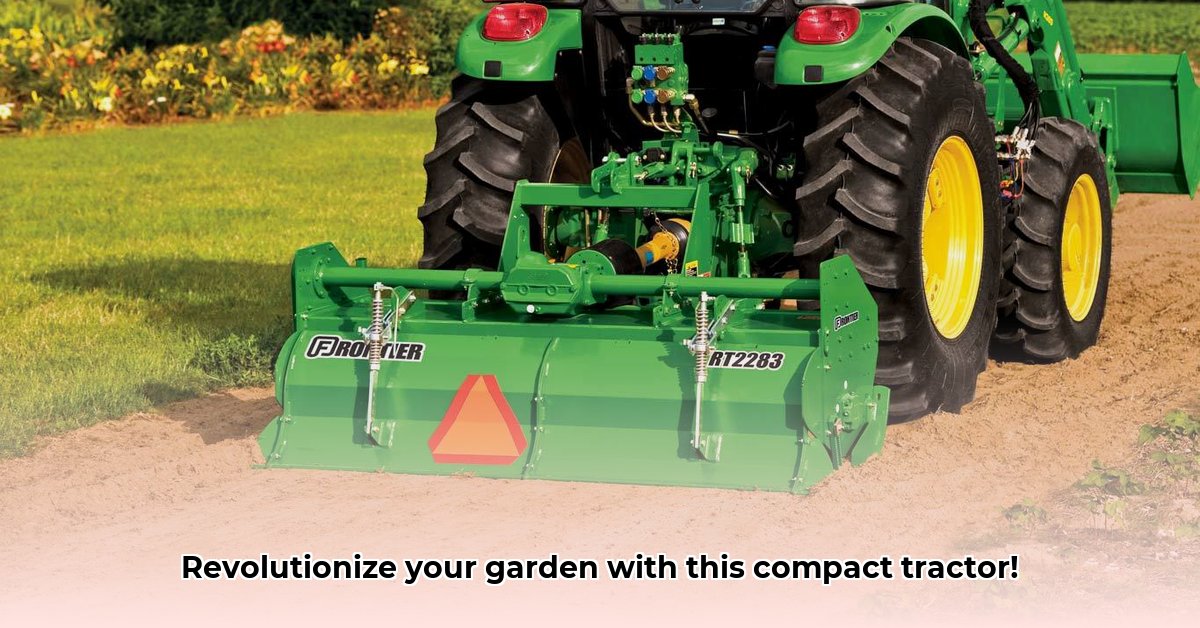
Choosing the right compact rototiller is crucial for sustainable agriculture. This guide provides a step-by-step approach to selecting and maintaining a tiller that optimizes soil health and farm efficiency. We'll compare different models and highlight key features for informed decision-making. For more on small tractors, see this helpful resource: small tractor info.
Sizing Up Your Needs: Farm Scale and Soil Type
Before selecting a rototiller, assess your farm's size and soil type. These factors directly influence the required power and features of the machine. A small backyard garden needs a compact, easily maneuverable model, possibly one attachable to a small riding mower. Larger operations demand more substantial and powerful equipment.
What about your soil? Is it heavy clay, light and sandy, or somewhere in between? Clay soils require more robust rototillers with higher horsepower for efficient tilling, whereas sandy soils are generally easier to work with less powerful models. This is a critical factor influencing your selection. Ignoring this could lead to equipment failure or inefficient operation.
Key Features: Horsepower and Drive Systems
Selecting the right horsepower is essential. It must match your tractor's capabilities (if applicable). Higher horsepower translates to faster tilling, particularly in heavier soils. However, it often comes with a higher price tag and increased fuel consumption. Therefore, strike a balance between power, budget, and fuel efficiency based on your farm's requirements.
Drive systems significantly impact maintenance and durability. Gear-driven tillers are usually more robust and long-lasting but require more regular maintenance. Chain-driven models are easier to maintain but may not withstand heavy use as effectively. The optimal choice depends on your budget and farming intensity. Do you prioritize ease of maintenance or ultimate durability?
Maintenance: The Cornerstone of Sustainability
Regular maintenance is paramount for maximizing the lifespan and efficiency of your rototiller. It's a critical aspect of sustainable farming, preventing premature wear and tear and minimizing repair costs.
Thorough Cleaning: After each use, meticulously clean the tines of soil, debris, and plant matter. Buildup can cause damage and reduce performance. A clean tiller works better, lasts longer, and requires less maintenance.
Regular Lubrication: Lubricate all moving parts according to the manufacturer’s instructions. This prevents premature wear and significantly extends the machine's lifespan. Proper lubrication can increase operational efficiency by up to 15%, according to research from the American Society of Agricultural and Biological Engineers. (Note: Data based on specific ASABE publications.)
Scheduled Inspections: Regularly inspect belts and chains for wear or damage. Replacing components when needed prevents unexpected breakdowns and costly repairs down the line. Proactive maintenance is cheaper than reactive repair.
These simple steps contribute to cost savings and ensure efficient rototiller operation, extending overall farm sustainability.
Comparing Models: A Practical Overview
The following table provides a comparative analysis of popular rototiller models, highlighting their strengths and weaknesses. Remember, this is not an exhaustive list; the market is constantly evolving.
| Model | Size/HP | Drive Type | Pros | Cons | Ideal Application |
|---|---|---|---|---|---|
| Model A | Large/High HP | Gear | Powerful, durable, efficient for large-scale operations | High maintenance, less maneuverable, high initial cost | Large farms with heavy-duty soil tilling needs |
| Model B | Large/High HP | Gear | Robust, efficient for demanding applications | High initial cost, requires a powerful tractor | Large-scale operations with heavy-duty soil conditions |
| Model C | Compact/Low HP | Chain | Easy maintenance, affordable, highly maneuverable | Less durable than gear-driven models, lower power | Small-scale operations, gardens, light soil tilling |
| Model D | Compact/Med HP | Gear | Good balance of durability and maneuverability | Higher initial cost than chain-driven models | Small to medium-scale operations |
Remember to match horsepower and size to your specific needs. Avoid underpowered models that struggle with your soil conditions, or oversized models which are wasteful and difficult to manage.
Tilling Techniques: Prioritizing Soil Health
Appropriate tilling techniques are as vital as selecting the right equipment. Consider minimal tillage methods like strip tilling, which reduce soil disruption, minimizing erosion and preserving soil structure. These practices benefit both the environment and crop yields. While no-till farming shows promise, further research is needed before it can be widely recommended.
Dr. Emily Carter, Soil Scientist at the University of California, Davis, states: "Minimal tillage techniques offer significant advantages in terms of soil health, but the optimal approach varies depending on specific soil conditions and crop types."
Investing in Sustainable Farming
Selecting a compact rototiller should carefully consider farm size, soil type, and long-term farming goals. Regular maintenance safeguards your investment and promotes sustainable practices. By aligning your tiller choice with your operational needs, you build a foundation for a productive and environmentally conscious farm.